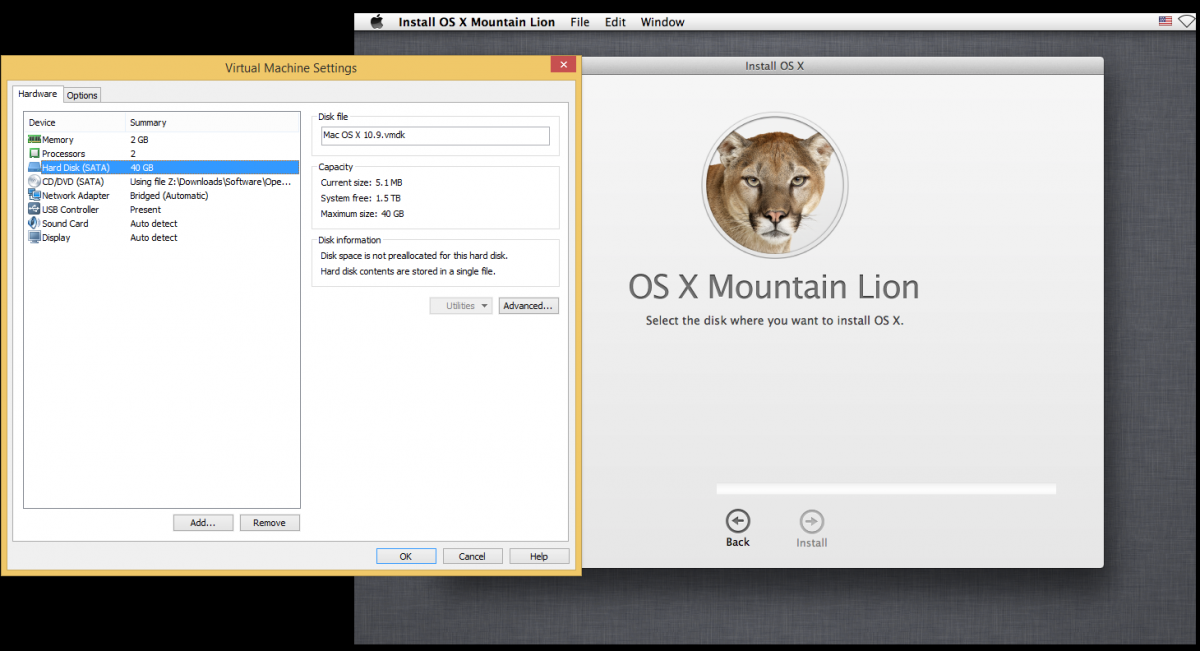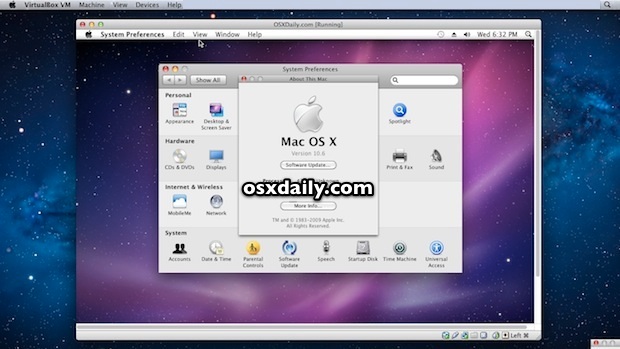Mac OS X 10.6 Snow Leopard was billed as primarily under-the-hood changes to OS X 10.5 Leopard, but it was much more significant than that.
Snow Leopard was announced at the June 2008 Worldwide Developer Conference (WWDC) and released on August 28, 2009.
For the first time since Mac OS 8.5 was released in October 1998, Apple left behind an entire processor architecture. In 1998, it left behind Motorola 680×0 CPUs in favor of PowerPC (the first PPC Macs hawered been introduced in March 1994). With OS X 10.6, Apple left behind PowerPC CPUs in favor of Intel (the first Intel Macs were introduced in January 2006).
If you like OS X Snow Leopard, Get a Mac. Step 1: Download and install VMware Workstation 7. Step 2: Download pre-made modified version of Snow Leopard.vmdk and darwinsnow.iso files required to get this thing to work. Please don’t ask for the link to these files. You can find them easily elsewhere on the web. Here is my video tutorial on how to install Mac OS X Snow Leopard in VMware!VMware:https://my.vmware.com/en/web/vmware/downloadsWinRAR:https://www.rarlab.com. Mac OS X 10.6 Snow Leopard DVD-ROM. Snow Leopard was publicly unveiled on June 8 at the 2009 Worldwide Developers Conference. On August 28, 2009, it was released worldwide, and was made available for purchase from Apple's website and its retail stores at the price of US$29 for a single-user license. As a result of the low price, initial sales. When asked which version of Mac OS X was the best, many Mac nerds will reply with Snow Leopard. Released in 2009 under the mantra “No New Features,” 10.6 did bring new things with it. Mail, iCal and Address Book were granted Microsoft Exchange integration, and as it was the first release to.

Snow Leopard is not impacted by the “goto fail” bug discovered in early 2014.
Big Changes with 10.6
- Snow Leopard is smaller than Leopard. By removing PowerPC and other unnecessary legacy code, Apple greatly reduced the drive space needed by the operating system. It takes up about half as much space and thus will install about twice as quickly as Leopard. That said, it makes more demands of your hardware, so a Mac that runs Leopard comfortably with 1 GB of memory may feel very sluggish with Snow Leopard once you have more than a couple apps running. We strongly recommend at least 2 GB of memory.
- Grand Central Dispatch (GCD) means that the entire operating system is designed to take advantage of multiple cores, whether on one chip or more than one. Process threads, which were handled by apps in the past, are now handled by the OS with new programs designed to use GCD. GCD will assign only as many threads to an app as it currently needs, which makes for better use of resources.
- Full 64-bit support means programs will no longer be limited to 4 GB of RAM; the new maximum (16 exabytes) is meaningless, as no computer in the forseeable future will be able to hold billions of gigabytes of memory. Both the OS and almost all “system applications” (Finder, Safari, Mail, iChat, iCal, etc.) are ready for 64-bit operation. And Snow Leopard is completely backwards-compatible with 32-bit apps. First generation Intel Macs designed around Intel Core Solo and Core Duo chips do not support 64-bit operation; all Macs since then do.
- OpenCL takes advantage of powerful modern graphic processing units (GPUs, a.k.a. “video cards”) for more than displaying video. All of that processing power will also be available for general purpose computing.
- QuickTime X introduced a new QuickTime player and will take full advantage of Core Audio, Core Video, and Core Animation. It can record audio and video using your Mac’s built-in microphone and webcam, and it can trim and export for iPod, iPhone, Apple TV, YouTube, and MobileMe so you don’t need to worry about which codec to use. QuickTime X supports HTTP live streaming, which can adjust quality on the fly based on available network bandwidth. Of course it takes advantage of GCD and 64-bit operation.
- Exchange Support is built right into the OS. Mail, iCal, and Address Book will work with Microsoft Exchange Server 2007. This may explain why Microsoft finally brought Outlook to the Mac with Office 2010. So long, Outlook.
- The Finder has been completely rewritten to support 64-bit operation and take advantage of Grand Central Dispatch. This makes the Finder much more responsive.
- For the first time, the Services menu is contextual: You will only see the services available to the current app. (Until now, half or more of the Services might be grayed out because they don’t work with your current program.)
- Exposé can work in the Dock – click and hold an application icon and it will display that app’s active documents in a grid. Apple claims this will make it “even easier to find what you’re looking for.”
- Time Machine backups are up to 50% faster, according to Apple. This will be especially helpful for that first, long, full backup.
- Macs shut down and wake up more quickly, and joining a WiFi network is also faster. This makes for more energy efficient file sharing – your sleeping Mac uses less energy and wakes more quickly to serve up files.
- If you travel with you’re Mac, you’ll appreciate automatic time zone settings.
- The ‘Wake on Demand’ feature may keep your Mac from staying asleep. The fix is to reset the Energy Saver settings to their defaults, then put in your own settings.
Things Lost with 10.6
- There is no support for LocalTalk/AppleTalk in Snow Leopard. You’ll need to find another way to connect those old printers.
- There is no longer any support for Palm OS devices in iSync. The Missing Sync (commercial software) does support Palm devices.
- Snow Leopard ignores creator codes when launching documents, something every Mac OS prior to 10.6 has supported – it’s been part of the Mac OS since the beginning.
- There is no write support for HFS+ volumes (floppies, hard drives, etc.)
Snow Leopard was replaced with OS X 10.7 Lion on July 20, 2011 after just 11 months at the helm.

Last Supported Software
As OS X has moved forward, more and more software has dropped support for Snow Leopard.
From Apple
From Other Vendors
Minimum Hardware Requirements
- Intel-based Mac
- 1 GB of RAM, although 2 GB is strongly recommended
- 5 GB of available drive space
- DVD-compatible optical drive
- Grand Central Dispatch requires a dual-core CPU
- 64-bit support requires a Core 2 or newer CPU
- OpenCL is compatible with all current Macs. It is not compatible with:
- iMacs released before March 2009
- Mac mini released before March 2009
- MacBook released before October 2008
- MacBook Pro released before June 2007
- Mac Pro released before January 2008 (Jan. 2008 and later models with unsupported video cards can used the discontinued GeForce 8800 upgrade kit – Apple part no. MB137Z/A – for OpenCL support. The GeForce GT 120 retails for $149, is designed to work with the 2009 Mac Pro and has been reported to work with the 2008 model as well.)
Further Reading
- New iMacs and MacBooks soon?, Blu-ray on Macs, looking back at Lisa and Mac Plus, and more, Mac News Review, 09.25. Also Snow Leopard sales data, using FreeHand and AppleWorks with Snow Leopard, affordable Pentax K-x DSLR even comes in red, and more.
- Cheap USB 2 CardBus solution, OS 9 and Kanga, mobile Mac value, and more, Charles W Moore, Miscellaneous Ramblings, 2009.09.09. Also a look at several options for using an old LocalTalk printer with a Mac running Mac OS X 10.6 Snow Leopard.
- 100 apps incompatible with ‘Snow Leopard’, Mac mini and SuperDrive firmware updates, and more, Mac News Review, 2009.09.04. Also August market share changes, retrieving a stuck disc, anti-malware in Snow Leopard, USB 3.0 certification begins, and more.
- Wake on demand in Snow Leopard, extended repair policy for MacBook Air hinges, big drives, and more, The ‘Book Review, 2009.09.04. Also Windows 7 great on a MacBook Pro, gScreen preparing dual display notebook, free OS X 10.6 deal from QuickerTek, bargain ‘Books from $179 to $2,294, and more.
Downloadable Updates
Download Mac Os X 10.6
Standalone Updates let you update to a newer version of Mac OS X from your hard drive instead of using Software Update, which requires an Internet connection. Download the one(s) you need and install them after mounting the disk image and launching the Installer program.
There are two types of Standalone Updates: Individual (or Delta) and Combo.
- Individual Updates update one version of Mac OS X to the next version. For example, the Mac OS X 10.6.4 Update updates Mac OS X 10.6.3 to version 10.6.4. Individual Updates are also known as Delta Updates.
- Combo Updates update the base version of a Mac OS X release to the version specified in the Combo Update, including all intermediate updates. For example, the Mac OS X 10.6.4 Combo Update updates any earlier version of Mac OS X 10.6 to Mac OS X 10.6.4 using a single installer, as opposed to installing the individual Mac OS X 10.6.1, 10.6.2, 10.6.3, and 10.6.4 updates.
Standalone Updates are generally available 24 to 48 hours after the Update is available through Software Update.
If you burn a Standalone Update to CD, its disk image must be copied to your desktop or another location on your Mac OS X startup disk in order to be installed.
This page will be updated as new Standalone Updates become available.
Mac OS X 10.6.1
Mac OS X 10.6.2

Mac OS X 10.6.3
Mac OS X 10.6.4
Mac OS X 10.6.5
Mac OS X 10.6.6
Version 10.6.6 introduced the Mac App Store.
Mac OS X 10.6.7
Mac OS X 10.6.8
Keywords: #osxsnowleopard #macosxsnowleopard #snowleopard
Short link: http://goo.gl/pPqRxm
Mac Os X 10.6 Snow Leopard Vmdk Iso
searchword: osxsnowleopard